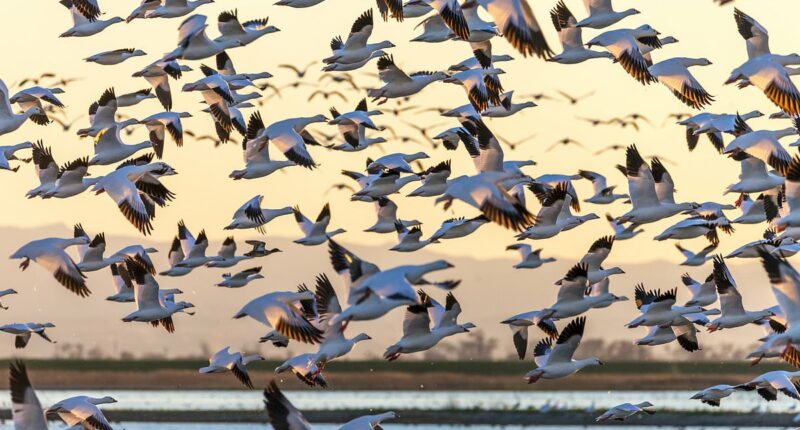Share this @internewscast.com
Birds throughout the US have adopted a disturbing habit that could have devastating implications for human society if it continues.
Scientists have discovered that birds are changing their usual migration routines, as warmer conditions in their wintering areas are disrupting their annual journeys.
Although postponing their yearly migration south might not seem significant, Andrew Farnsworth, a visiting scientist at Cornell University, cautioned that this could lead to many bird species facing extinction and significantly impacting the natural world.
Birds play an important role for people because they help control pests, spread seeds, and pollinate plants.
Roughly five percent of the plants used for food and medicine by humans rely on birds to pollinate them.
If more birds die out because they struggle to find food when the seasons change, food production drops and the balance of nature is disrupted.
Farnsworth, a specialist in migration ecology, explained that increasing temperatures in regions like the Arctic and northern forests, combined with challenges such as wildfires, are making bird survival more difficult.
Overall, the National Audubon Society has warned that 389 North American bird species will become vulnerable to extinction within the next 50 years.

Researchers have warned that birds have started changing their migration schedules, which could lead to a mass population drop (Stock Image)
Audubon, a US nonprofit focusing on conserving birds and their environments, reported that these 389 species account for nearly two-thirds of the species they examined.
Researchers warned that these birds were at risk of losing more than half of their habitats by the year 2080.
A study by the Cornell Lab of Ornithology revealed that approximately three billion birds in North America have been lost since 1970.
When birds die off en masse, it quickly impacts the pollination of tropical plants, such as bananas, coffee, and cacao, which produce chocolate.
Medicinal plants, including those used in traditional remedies or medical applications, like orchids or aloe species, might also diminish, restricting access to natural health solutions.
With ongoing declines in bird populations, farmers may struggle to produce sufficient food, potentially escalating costs and impacting global food availability.
The main driver of this mass extinction event was found to be birds losing their living spaces, worsened by climate change, pesticides, and other human-related impacts like urban development and window collisions.
‘There’s this very close relationship between where birds are when on the planet and what’s happening with the climate and what’s happening with weather,’ Farnsworth told NBC Connecticut.

Changing migration schedules can be fatal because it leads to birds showing up at feeding and mating sites when there isn’t enough food available to survive (Stock Image)
Rising global temperatures have changed the timing of seasons, causing birds in warming regions to leave their nests earlier or later than usual.
This can mean they arrive at breeding or feeding grounds before food like insects or plants is available.
Birds can end up starving, not finding suitable shelter, and struggling to find a mate, leading to smaller and smaller populations as less birds survive the winter.
Several species in the US have already been affected by this changing behavior, including the Black-throated Blue Warbler, Red Knot, and Swainson’s Thrush.
Researchers with Audubon found that Black-throated Blue Warblers have seen their populations drop off in the US due to climate-driven mismatches that have left the birds with less food when they migrate from North America to the Caribbean.
Red Knots, a shorebird that lands in the US during its migration from the Arctic to South America, have seen their populations decline by around 75 percent.
The Cornell Lab found that warming Arctic temperatures have disrupted their breeding grounds, while rising sea levels have shrunk their coastal feeding sites.
Meanwhile, the Swainson’s Thrush, which migrates from breeding grounds in Canada and Alaska to wintering areas in Central and South America, has been dying out due to climate-driven habitat loss from wildfires and warming forests
This has destroyed their nesting and stopover sites in California, Oregon, Washington, New York, Maine, and Colorado.
‘We do see birds track climate change, obviously some are managing to do it, but the challenge is for those that can’t,’ Farnsworth explained.
Researchers have noted that people who feed birds make the problem even worse, making them less incentivized to leave and by attracting predators that attack birds who stay.
















